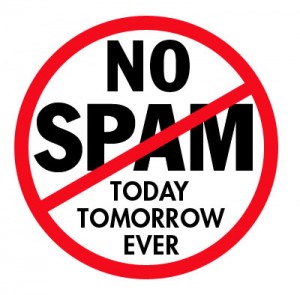If you send email campaigns long enough, you will inevitably run into spam filter issues. You would find roughly 10-20% emails get lost in cyberspace mostly due to spam filters. You don’t even have to be a spammer to get your mails spam-filtered. Innocent email marketers who send permission-based emails to people who requested them also get spam-filtered all the time.
Unfortunately, there is no quick fix. The only way to avoid spam filters is to understand how they work. The complicated part is that spam filters look at a long list of criteria to judge whether or not your email is junk. Commonly they look for popular spammy words like CLICK HERE or FREE or BUY NOW, etc. and assign points each time they see them. For instance, MailDirect uses Spam Assasin, one of the most popular filters, which will assign scores as follows:
- Message body has 70-80% blank lines – 1.668
- Subject is all capitals – 0.763
If your campaign’s total spam score exceeds the threshold, your email will land into the Junk/Spam folder; and to complicate the situation further, every server will have its own defined threshold.
Common mistakes to avoid:
These are the most common mistakes we see new email marketers make, which result in accidental spam filtering.
Be compliant with CAN-SPAM Act
If you are sending “any electronic mail message, the primary purpose of which is the commercial advertisement or promotion of a commercial product or service,” then you must comply with the following main requirements:
- Don’t use false or misleading header information
- Don’t use deceptive subject lines
- Identify the message as an ad
- Tell recipients where you’re located
- Tell recipients how to opt-out of receiving future email from you
- Honor opt-out requests promptly
- Monitor what others are doing on your behalf
If your email contains only transactional emails or relationship content, then you are exempt from these rules; however, you must still not include false or misleading routing information.
Avoid Spam trigger words or Phishing phrases
There is really no complete list of spam trigger word. However, I found a few on the following link http://blog.mannixmarketing.com/2009/08/spam-trigger-words/.
Apart from these, a few common rules of what not to do are:
- Using spammy phrases, like “Click here!” or “Once in a lifetime opportunity!”
- Going crazy with exclamation points!!!!!!
- USING ALL CAPS, WHICH IS LIKE YELLING IN EMAIL (especially in the subject)
- Coloring their fonts bright red, or green
- Coding sloppy HTML (usually from converting a Microsoft Word file to HTML)
- Creating an HTML email that’s nothing but one big image, with little or no text (since spam filters can’t read images, they assume you’re a spammer that’s trying to trick them).
- Using the word “Test” in the subject line (agencies run into this all the time, when sending drafts to clients for approval)
- Sending a test to multiple recipients within the same company (the company’s email firewall can only assume it’s a spam attack)
- Designing HTML email in Microsoft Word, and exporting the code to HTML (this code is sloppy, and spam filters hate it)
- Include a text version of your email if you are sending HTML emails.
Use permission marketing techniques
The well known digital marketer Seth Godin who coined the phase “Permission Marketing” has some good insights to share (http://sethgodin.typepad.com/seths_blog/2008/01/permission-mark.html). Please make sure you ask your customers for the permission to send them emails. Please send emails only to those whom you know. If executing through a third party, make sure this instruction is followed.
Use Spam Checkers
MailDirect uses Spam Assasin as a spam checking tool for emails.
Maintain a good text to image ratio
It is usually best to not include images at all; however, if you must include images, here are some tips:
- Do not send emails comprising of images only
- We suggest that for every graphic, include at least two lines of text
- Optimize your images as best as you can
- Use well-formed HTML for email
Avoid Spam Traps
Spam Traps are email addresses that are flagged by ISPs as being no longer used by a human, so it then stands to reason that there could have been no opt-in. To avoid including a Spam Trap email in your mailing list, use an opt-in process and do not buy lists from email brokers.
Check your attachments
In general, .jpg, .gif, .png and .pdf attachments are safe to send, provided you include some content in the email as well. However, executable attachments such as .exe, .zip, .swf, etc. should be avoided entirely. Generally, you should not send attachments to people on your list that are not expecting them.
Make sure Make Sure Your DKIM, SPF, Sender-ID and Domain Keys Are Setup Properly
You will want to make sure your email server supports these protocols (DKIM, SPF, Sender-ID and Domain Keys) and that they are properly implemented.
This is by no means meant to be an definitive guide to ensuring that your campaigns land in the inbox – there are just way too many factors that services like Gmail and Yahoo use to determine whether a message is good or junk. And as the spammers figure these out, they go ahead and change all over again. So, in the final analysis, all that can be said is that if your message is genuine, and the recipient has opted for your messages, and if you’ve contacted her successfully before in the past, your next campaign will most likely hit her inbox and not the junk-mail folder.
And in the mean time, we’ll keep sharing the good practices that we know to help you run successful campaigns to your opt-in lists, so stay in touch with this site.
Happy marketing!

No Comments